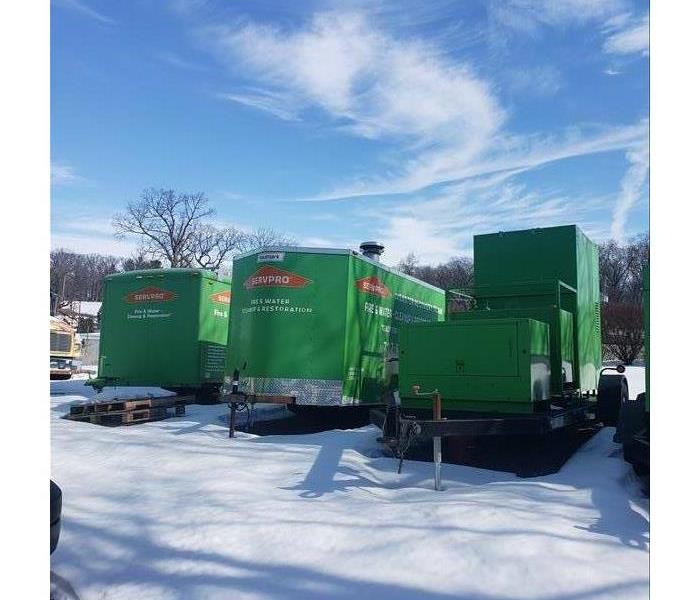Give Winter Fires the Cold Shoulder
2/17/2022 (Permalink)
Did you know that, statistically, fires occur more often throughout winter than during any other season? Electrical issues, heating sources, carbon monoxide, and portable generators are all contributing factors that lead to an increased risk of a home fire during winter months. Below are some of the leading causes of winter fires. The professionals at SERVPRO of East York hope that you will be able to take the appropriate steps to protect your home and family once you know the risks that you are facing.
ELECTRICAL FIRES
Electrical fires are one of the leading causes of home fires throughout the United States. Approximately half of all residential electrical fires involve inadequate electrical distribution, or the use of lighting equipment. Other electrical fires occur from things like overloaded circuits, dryer fans, and portable space heaters.
Electrical Safety Tips:
- Check electrical cords often. Replace cracked, damaged, and loose electrical or extension cords. Do NOT try to repair them.
- Home appliances should be plugged directly into a wall outlet. To reduce your risk of fire, unplug small appliances when they are not in use.
- Be aware that extension cords are for temporary use only. Have a licensed electrician determine if additional circuits or wall outlets are needed in your home.
- Only use surge protectors / power strips that have internal overload protection.
- Avoid putting cords under rugs / carpets, across doorways, or where they can be damaged or pinched by furniture,
Call a licensed electrician if any of the following apply:
- You see sparks from a wall outlet
- You experience flickering lights outside of a storm event.
- You have reoccurring issues with blown fuses or tripping circuit breakers.
- You experience a tingling feeling when you touch an electrical appliance.
- There is a burning odor coming from an appliance.
- You notice discolored wall outlets and/or switches.
- You have cracked or broken wall outlets
HEATING SOURCES
Heating sources are the second leading cause of residential fires in the United States. December, January, and February are the peak months for heating fires to occur, and space heaters are the most common heating source involved in heating-related fires. Space heaters account for approximately 44% (more than two out of every five) heating-related fired, and also account for the vast majority of deaths and injuries in home fires caused by heating equipment.
Space Heater Safety Tips:
- Before using any space heater, read the manufacturer’s instructions and warning labels.
- Inspect heaters for cracked or broken plugs and any loose connections before each use.
- Never leave a space heater unattended. Turn it off when you're leaving a room or going to sleep.
- Proper placement of space heaters is critical. Heaters must be kept at least three feet away from anything that can burn, including papers, clothing, and rugs.
- Plug space heaters directly into a wall outlet. Do not use an extension cord or power strip.
- Place space heaters on level, flat surfaces.
- Always unplug and safely store the heater when it is not in use.
For other heating safety tips, read our Heating Safety Tips blog:
https://www.SERVPROeastyork.com/blog
CARBON MONOXIDE
Carbon monoxide is often referred to as the invisible killer. Carbon monoxide (CO) is an odorless, colorless gas created when fuels like gasoline, wood, coal, propane, etc… do not burn completely. In the home, heating and cooking equipment that burn fuel are potential sources of Carbon monoxide. Carbon monoxide incidents are more common during the winter months in residential properties.
Carbon Monoxide Safety Tips:
- Install carbon monoxide alarms on every level of your home, especially near sleeping areas.
- If you need to warm a vehicle prior to driving, remove it from the garage immediately after starting it. Do not leave the engine running if the garage door is open.
- Ensure that vents are properly cleaned and free of debris.
PORTABLE GENERATORS
Portable generators are often used during power outages. Though handy, most homeowners are unaware that improper use of a portable generator can be risky. The most common dangers associated with portable generators are carbon monoxide (CO) poisoning, electrical shock, and fire hazards
Portable Generator Safety Tips:
- Portable generators should be used outside the home, away from windows and doors.
- Portable generators should be kept away from open flames or fuel burning appliances
- Do not overload cords; check for the generators maximum wattage listed on label.
- Do not refuel the generator while it's running or when hot; turn the generator off, let it cool before refueling.
CALL THE PROFESSIONALS
If you have experienced a fire, regardless of the cause, call SERVPRO of East York at 717-665-1270. SERVPRO’s mission is to develop a team of quality people who focus on excellent service, fairness, and mutual respect. When you call SERVPRO of East York, you are calling a team of trained professionals that are looking to restore your home “Like it never even happened,” as quickly and efficiently as possible.



 24/7 Emergency Service
24/7 Emergency Service